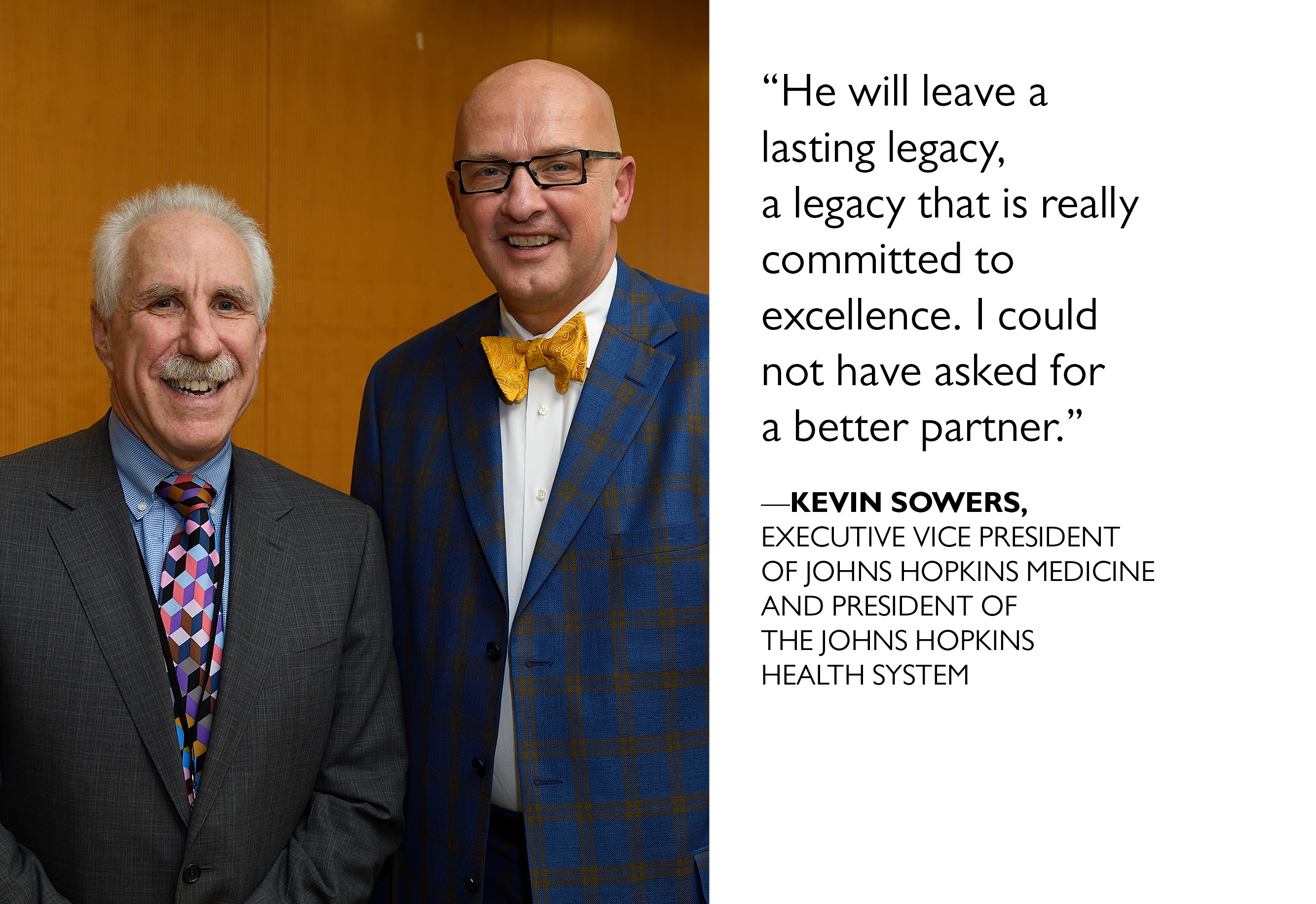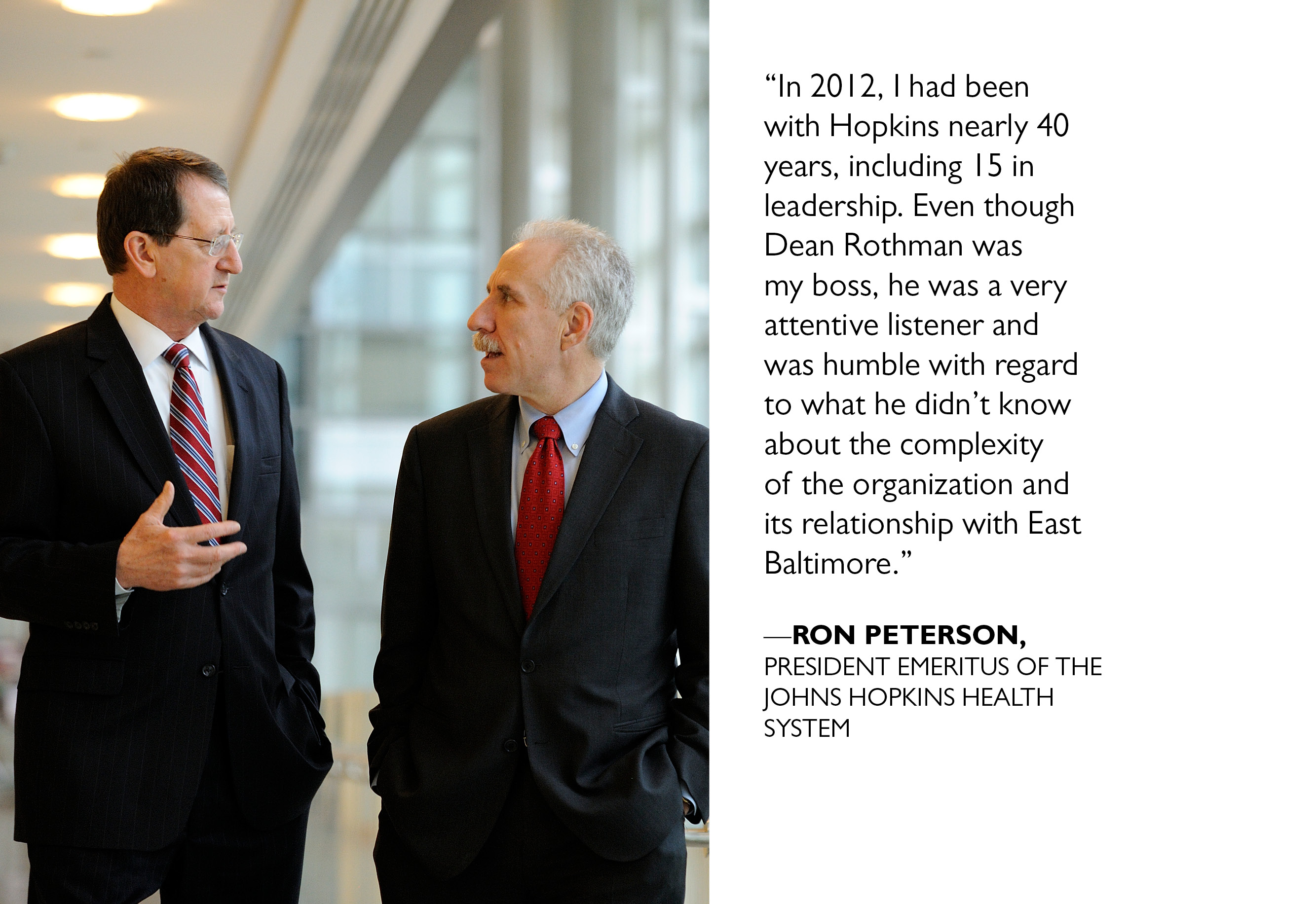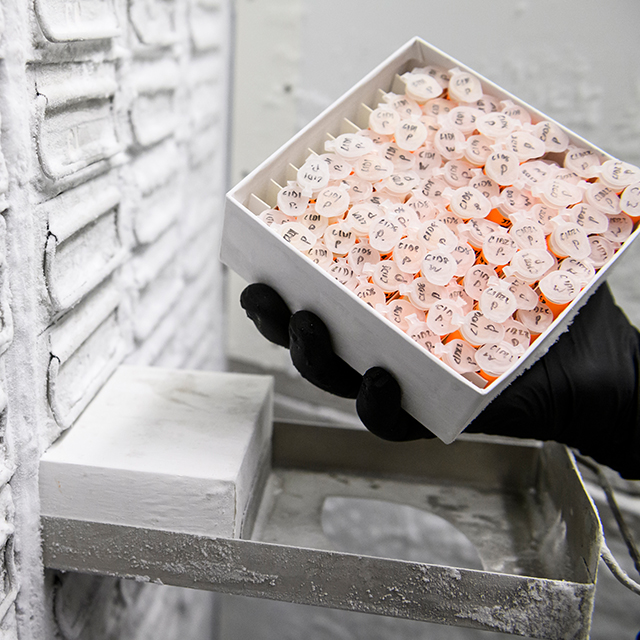Paul B. Rothman became dean of the medical faculty and CEO of Johns Hopkins Medicine on July 1, 2012, taking the reins of a storied institution in the midst of tremendous growth and change.
As he retires at the end of June, marking the end — to the day — of 10 years of leadership, he leaves behind a health system and school of medicine that are more integrated and innovative, making them well positioned for the next generation of growth and challenges.
Self-effacing by nature, Rothman is the first to point out that no Johns Hopkins success is his alone. He works closely with people across the institution, including the two health system presidents who shared his time at Hopkins: Ronald R. Peterson, who retired at the end of 2017, and Kevin W. Sowers, who started in 2018.
“He will leave a lasting legacy, a legacy that is really committed to excellence. I could not have asked for a better partner,” says Sowers, executive vice president of Johns Hopkins Medicine and president of the Johns Hopkins Health System.
Adds Redonda Miller ’92, president of The Johns Hopkins Hospital since 2016, “On a personal level, I have always admired Dean Rothman for his kindness and good humor. But professionally, what I will remember most is his ability to cut through all of the noise in a discussion or presentation and hone in on what is important. He is incredibly insightful. He is interested in the substance of what we’re doing. That speaks to who he is at his core — a scientist with a love of data and evidence-based discovery.”
Known across the institution for his quiet determination to do the right thing for patients, the community, learners and employees, Rothman says he is proudest of the way Johns Hopkins Medicine is pioneering the use of data to advance research, clinical care and education.
Because of his advocacy, JHM now supports dozens of precision medicine centers of excellence that use large amounts of data to better understand how diseases including Alzheimer’s disease, cystic fibrosis and prostate cancer vary by individual and how treatments can be tailored to specific patients.
One of the newer centers of excellence is devoted to COVID-19, the disease that claimed millions of lives worldwide and dominated the last two years of Rothman’s time at JHM.
“Paul has been an incredible leader throughout the COVID-19 pandemic,” says Brian Garibaldi, the pulmonologist who is leading the Johns Hopkins Precision Medicine Center of Excellence for COVID-19.
“Not only has he helped fund our efforts in precision medicine, he has been an active participant in research discussions that have shaped our agenda and helped us solve important problems related to data management and governance.”
When Johns Hopkins hospitals began treating patients with COVID-19 in March 2020, little was known about the coronavirus that causes it, except that it is highly contagious and potentially lethal. Vaccines were almost a year away.
Johns Hopkins responded to the global pandemic with both strength and nimbleness, setting itself apart as a beacon of light through a time of confusion and darkness. Leaders used the best available knowledge to make exquisitely painful decisions, such as restricting the number of visitors per patient, and, later, requiring full vaccination and booster shots — with very few exceptions — as a condition for employment.
Rothman says two principles guided his leadership during COVID-19: Follow the science, and do everything possible to keep patients and staff safe.
“If you’re always guided by the values that we’re guided by — honesty, integrity, making sure we’re improving the health of our community,” he said in April, “if you follow that North Star, you’re never really going to go wrong.”
The pandemic tested just about everyone at Johns Hopkins, particularly front-line clinicians who worked long hours in cumbersome protective gear, sometimes in unfamiliar roles and often worried about their own safety as they tended to frightened and isolated patients.
“What came across was his concern for our staff and desire to really understand their challenges in the face of the pandemic,” says M. Shafeeq Ahmed, president of Howard County General Hospital, recounting one of Rothman’s visits during a surge in patients with COVID-19. “He was genuine and approachable, which was great to see during an especially challenging time for our organization.”
COVID-19 highlighted existing health disparities, causing disproportionate harm to people in already disadvantaged communities, particularly people of color.
In the spring and summer of 2020, racial tensions turned to emotional protests following the violent deaths of George Floyd and other unarmed Black people at the hands of police. Johns Hopkins responded by affirming its commitment to equity and racial justice.
On June 5, 2020, health care workers at all six Johns Hopkins hospitals knelt together during a national moment of silence as part of an event organized by White Coats for Black Lives, a national group founded by medical students. The institution continued to build community trust by bringing COVID-19 information, testing and vaccines to people in the neighborhoods surrounding Johns Hopkins hospitals.

A Time of Change
Rothman wasn’t looking for a job when he was recruited in 2011 from the University of Iowa, where for three years he had been dean of the Carver College of Medicine and leader of the university’s clinical practice plan.
A rheumatologist, he was also leading an active research program on the role of cytokines in the development of blood cells called leukocytes — the abnormal development of which can lead to leukemia — and in immune responses to asthma and allergies.
But he couldn’t pass up the opportunity to take on the dual role of medical school dean and CEO of the health system at Johns Hopkins.
When he arrived, the health system was adjusting to a recent growth spurt. In the previous two years, it had added three community hospitals — Sibley Memorial Hospital in Washington, D.C.; Suburban Hospital in Bethesda, Maryland; and All Children’s Hospital in St. Petersburg, Florida.
Two massive clinical towers were about to open on the East Baltimore campus, the Sheikh Zayed bin Sultan Al Nahyan Tower and The Charlotte R. Bloomberg Children’s Center.
“What really stands out for me personally is the tone that he set from the very beginning regarding our working relationship,” says Peterson, who retired at the end of 2017 and is now president emeritus of the Johns Hopkins Health System.
“In 2012, I had been with Hopkins nearly 40 years, including 15 in leadership. Even though Dean Rothman was my boss, he was a very attentive listener and was humble with regard to what he didn’t know about the complexity of the organization and its relationship with East Baltimore.”
To bring together the various pieces of the new, larger institution, Rothman tapped about 150 stakeholders from across the enterprise to help craft JHM’s first comprehensive five-year strategic plan. Launched in June 2013, the plan outlined six priorities: people, biomedical discovery, patient- and family-centered care, education, integration and performance.
![“ Professionally, what I will remember most is [Dean Rothman’s] ability to cut through all of the noise in a discussion or presentation and hone in on what is important. He is incredibly insightful.” — REDONDA MILLER](-/media/images/articles/2022/06/rothman_in-story-graphic2.jpeg)
Rothman led creation of the Office of Diversity and Inclusion (now the Office of Diversity, Inclusion and Health Equity) and the Office of Well-Being to foster an environment in which all clinicians, researchers, nurses and staff can thrive personally and professionally.
He supported creation of the annual Catalyst and Discovery Awards programs to help early-career faculty and cross-divisional teams, and championed the annual Johns Hopkins Medicine Clinical Awards for Physicians and Care Teams to honor the excellent work of Johns Hopkins clinicians.
“Dean Rothman’s advocacy for developing a robust promotion pathway for our clinicians of excellence has been an important milestone in our clinical faculty being recognized and valued at our institution,” says Sherita Golden, vice president and chief diversity officer.
A student debt initiative, expected to launch this year, will replace school of medicine education loans with scholarships in order to create more opportunities for future physicians of diverse backgrounds.
To foster innovation, Rothman marshalled philanthropic support to launch several important institutes, including the Bloomberg~Kimmel Institute for Cancer Immunotherapy, the Skip Viragh Center for Pancreatic Cancer Clinical Research and Patient Care, the Armstrong Institute Center for Diagnostic Excellence, the Cochlear Center for Hearing and Public Health and the Center for Psychedelic and Consciousness Research.
He also supported an entrepreneurial approach to innovation with the 2014 launch of Johns Hopkins Technology Ventures, which helps Johns Hopkins researchers bring their technologies, products and services to market.
One of his fondest Hopkins memories is being part of a bucket brigade that saved lab mice after Hurricane Sandy landed on Oct. 29, 2012, knocking out power and flooding the Koch Cancer Research Building.
“Literally hundreds of people came out and we formed a human chain to get the mice out of the basement,” Rothman recalled. “It showed me the spirit of this place.”
Rothman is turning the reins over to Theodore DeWeese, vice dean for clinical affairs and president of the Johns Hopkins Clinical Practice Association, who will begin serving as interim dean and CEO on July 1, 2022.
Looking back, Rothman sees much to celebrate, but mostly he sees the people who make Johns Hopkins Medicine so special.
“The commitment of our faculty, staff and trainees — indeed, the entire JHM community — continues to inspire me,” he says. “In my time here, JHM lived up to and exceeded its legacy in our provision of care, in our improvement of the human condition through research, and in our teaching and training of the next generation of clinicians and scientists.”



